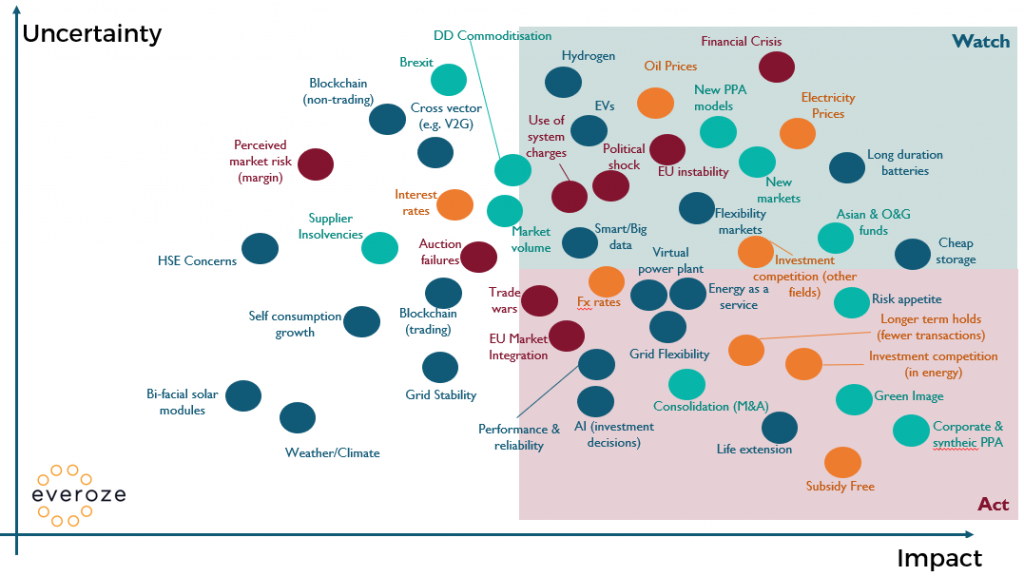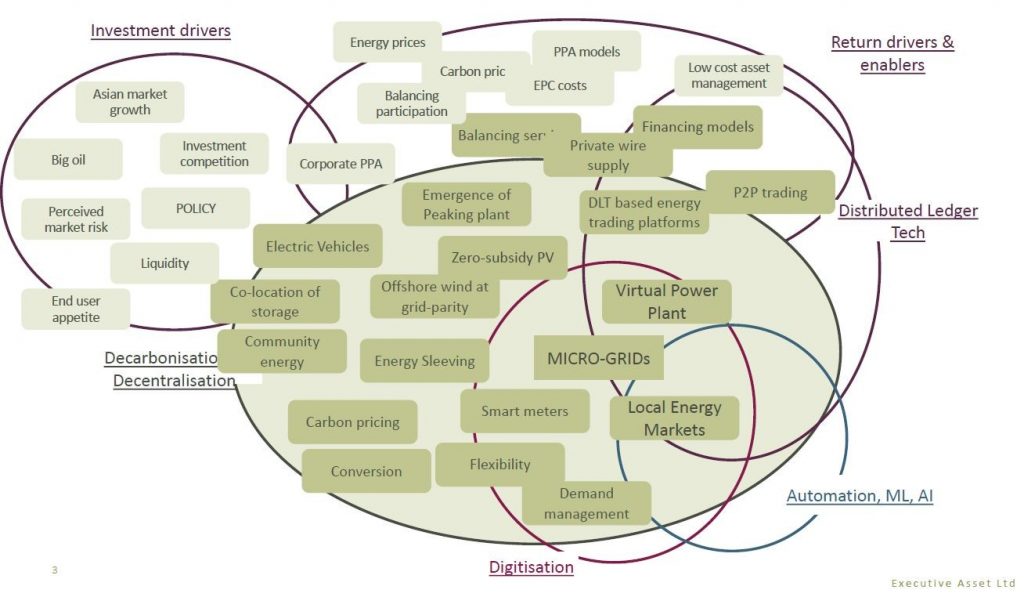From the alps to the boardroom: 4 market-tested insights into our evolving energy landscape
23 October 2018
Everoze founding partner Jo de Montgros shares insights on risks and opportunities for emerging and underlying market trends through the eyes of our clients in her latest blog.
As Everoze moves smoothly into Year 4 of operations, it was with some pleasant reflection that I recently walked past the venue of our launch party (just over 3 years ago). The anniversary feels like quite a milestone. Our journey has been far more complex and rewarding than I might have imagined from looking at a conventional 2-dimension business lifecycle chart (think > act > grow > evolve). What really stood out for me in our third year was how naturally the internal strategic discussion evolved; from establishing our own core processes towards an increasing focus on the challenges faced by our clients within shifting energy markets.
At our annual company get together this June – helped along by the invigorating backdrop of the French Alps and lots of frisbee playing – we explored emerging and underlying market trends through the eyes of our clients. On the basis that risk and opportunity are two sides of the same coin, we adopted a classic risk based approach with an axis for UNCERTAINTY and an axis for IMPACT. A similar approach is well illustrated by the work of the World Energy Council.

Over the rest of the Summer we embarked on a series of discussions with key investment clients and a broad consortium of other industry influencers. Our objective was to invite challenge and alternatives perspectives on the emerging trends we had identified. The sessions made for some truly fascinating, challenging and insightful conversations. Working collaboratively, we discussed the topics we had identified, found common terminology, linkages and drivers, and identified hot-spots.
For this blog, I’ve taken the liberty of cherry-picking just four key insights:
1. Merchant risk = opportunity for Oil & Gas capital
Ongoing high liquidity from global investors is likely to be boosted further by money from the oil and gas sector; increasing pressure on investors to develop new competitive strategies or to reduce transaction costs to reflect lower success rates. The good news is that more attention from merchant-risk-comfortable developers is seen as an enabler for increased new capacity.
2. Storage as an asset class – new structures needed to unlock potential
Revenue cannibalisation risk and uncertainty over operational models remain a high barrier to entry for many industry investors in new asset classes; the signals for balancing markets are neither certain or long term. All recognised the likelihood of increased presence of storage in combination with conventional generation – whether for grid services, balancing or trading. The key challenge facing storage investors now is finding the right structures to transparently and fairly allocate revenue risk; for instance, PPA and VPP providers shouldering more of this risk through price floors, or better optimising battery behaviour with respect not just to maximising revenue, but also for State of Health.
3. A mixed-tech asset base requires new thinking on evaluation and oversight
Diversification is a key theme for new funds; this is both into focus areas such as sustainability platforms as well as a remit for investment into new technologies or geographies. Everoze’s own journey into new forms of energy storage, vehicle-to-grid and wider flexibility services shows that this trend is not limited to the financial community. For investors however, organisational bandwidth can limit the ability to deeply assess the bewildering range of opportunities out there, including complex aggregated portfolios. An opportunity exists for mixed-technology evaluation and oversight capability to be outsourced.
4. Efficient asset management and optimisation strategies will be key to dealing with high liquidity
High liquidity will continue to put pressure on risk/return profiles, although all investors we spoke to were confident in their own current positioning. There was a feeling that some investments are being valued too tightly for the natural variability of assets – coupled with anecdotal evidence that variability may be increasing with recent weather events. In a sector with such a high emphasis on cost reduction, Everoze recognises that those who are able to optimise operational strategies and pro-actively manage lifetime risk will find more margin to cover these uncertainties.
We were inspired by the willingness shown by all to engage enthusiastically with us on this strategic initiative. Many we spoke to had seen some level of similar discussions internally within their own organisations. And while this is the normal business of regular strategic evaluation; the uncertain direction of the energy sector and the influences of fast technology evolution and growing competition seem to make this a uniquely interesting time to pause for breath and look ahead.
In the next phase we engaged with Barney Rhys Jones at Executive Asset (formerly of strategy consultants Bain and Company and investment director with Oxford Capital). Together we further developed the mapping with a particular focus on drivers of liquidity, drivers of returns, convergence of underlying technologies and their collective impact on existing and emerging energy technologies and business models. An extract from the wider mapping process is shown below. The resulting wider framework has helped us to map and follow industry activity and emerging opportunity; it also helps identify potential blind-spots within this complex network.

If you feel there would be value in running through the emerging perspectives and heat map, in the context of your own strategic objectives, then feel free to give us a call – we are always happy to share perspectives.
And just to prove that Everoze really knows how to set the scene for strategy meetings, I‘ll leave you with this …




